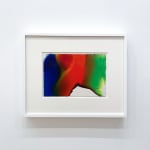


Paul Jenkins
Phenomena White Front Center, 1990
Watercolor on paper
8 x 12 in. (20.3 x 30.5 cm)
Copyright Upsilon Gallery
Further images
Signed in ink, lower right. Jenkins' interest in phenomenology—the study of experience and consciousness—was sparked in 1959 after engaging with Kant’s philosophy and Goethe’s color theories. From that point on,...
Signed in ink, lower right.
Jenkins' interest in phenomenology—the study of experience and consciousness—was sparked in 1959 after engaging with Kant’s philosophy and Goethe’s color theories. From that point on, he began titling his works with Phenomena, followed by a descriptive word or phrase, signaling his ongoing inquiry into perception. In this composition, prismatic veils of color descend toward a central white void, creating a striking contrast with the cascading hues. These fluid washes mingle and overlap, forming a dynamic narrative of color in motion. Rooted in his fascination with the nature of consciousness, Jenkins evokes a chromatic and ever-shifting sense of perception. His watercolor drips on paper recall Newtonian prisms refracting light through glass, while dark boundaries between colors press against areas of negative space, particularly along the lower and right edges. As colors converge on a richly saturated plane, the viewer is invited to examine their interactions and the ephemeral moments they create.
Jenkins' interest in phenomenology—the study of experience and consciousness—was sparked in 1959 after engaging with Kant’s philosophy and Goethe’s color theories. From that point on, he began titling his works with Phenomena, followed by a descriptive word or phrase, signaling his ongoing inquiry into perception. In this composition, prismatic veils of color descend toward a central white void, creating a striking contrast with the cascading hues. These fluid washes mingle and overlap, forming a dynamic narrative of color in motion. Rooted in his fascination with the nature of consciousness, Jenkins evokes a chromatic and ever-shifting sense of perception. His watercolor drips on paper recall Newtonian prisms refracting light through glass, while dark boundaries between colors press against areas of negative space, particularly along the lower and right edges. As colors converge on a richly saturated plane, the viewer is invited to examine their interactions and the ephemeral moments they create.
Provenance
Private Collection, New YorkJoin our mailing list
* denotes required fields
We will process the personal data you have supplied in accordance with our privacy policy (available on request). You can unsubscribe or change your preferences at any time by clicking the link in our emails.


